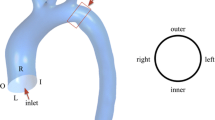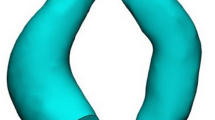Abstract
Pressure gradient across coarctation of aorta (CoA) is conventionally computed from phase contrast magnetic resonance imaging (PC-MRI) by applying the Bernoulli equation to the peak blood flow velocity measurement obtained just distal to the aortic narrowing. In order to test the validity and accuracy of the Bernoulli flow assumptions of negligible viscous forces in assessment of pressure gradients across the coarctation, we sought to determine pressure information from patient-specific computational fluid dynamics (CFD) simulation, modeling Newtonian, viscous, incompressible blood flow under steady and pulsatile inflow conditions. The transient high velocity jet observed though a moderate thoracic aortic coarctation model (65% area reduction) reconstructed from magnetic resonance angiography scans of an 8-year old female patient provided for the 2012 STACOM CFD challenge, was studied over a cardiac cycle under patient-specific flow conditions. Descending aorta hemodynamics was contrasted with a geometrically and dynamically comparable normal aorta simulation. The peak velocity of the modeled CoA jet (6.99 m/s) was observed to occur ~2 cm distal to the site of coarctation. The magnitude of this velocity was found to be similar to appropriately dynamically scaled clinical observations (6.00±0.6 m/s) of peak velocity obtained from PC-MRI data on three pre-surgical CoA patients, evaluated at Children’s Hospital of Pittsburgh. Bernoulli pressure gradient across the CoA computed using the CFD velocity field at the peak-systole instant of pulsatile flow grossly overestimated the true gradient predicted from CFD (30 mm Hg) when unsteady jet wake effects were more pronounced, but underestimated the CFD pressure gradient at steady time-averaged inflow conditions (5.8 mm Hg). Based on this pilot study, CFD determined flow fields are a more reliable clinical indicator of pressure gradient which considers viscous flow and complex jet wake interactions affecting hemodynamics downstream of CoA.
Access this chapter
Tax calculation will be finalised at checkout
Purchases are for personal use only
Preview
Unable to display preview. Download preview PDF.
Similar content being viewed by others
References
Arzani, A., et al.: In vivo validation of numerical prediction for turbulence intensity in an aortic coarctation. Ann. Biomed. Eng. 40(4), 860–870 (2012)
Madan, S., Mandal, S., Tadros, S.S.: Magnetic Resonance Angiography Basics to Future. In: Shabana, W. (ed.) Magnetic Resonance Angiography of Aortic Diseases in Children. InTech (2012)
Payli, R., et al.: High Performance Clinical Computing on the TeraGrid: Patient-Specific Hemodynamic Analysis and Surgical Planning. In: TeraGrid 2007 Conference 2007, Madison, WI (2007)
Pekkan, K., et al.: Embryonic intra-cardiac flow fields at 3 idealized ventricular morphologies. In: APS, Milwaukee, USA (2009)
Menon, P.G., et al.: Device specific analysis of neonatal aortic outflow cannula jet flows for improved cardiopulmonary bypass hemodynamics. In: 64th Annual Meeting of the APS Division of Fluid Dynamics, Baltimore, Maryland (2011)
Menon, P.G., et al.: Device specific aortic outflow cannula jets studied using 2D PIV and high-performance 3D CFD simulation. In: ASME Summer Bioengineering Conference, Fajardo, Puerto Rico (2012)
Konen, E., et al.: Coarctation of the aorta before and after correction: the role of cardiovascular MRI. AJR Am. J. Roentgenol. 182(5), 1333–1339 (2004)
Author information
Authors and Affiliations
Editor information
Editors and Affiliations
Rights and permissions
Copyright information
© 2013 Springer-Verlag Berlin Heidelberg
About this paper
Cite this paper
Menon, P.G., Pekkan, K., Madan, S. (2013). Quantitative Hemodynamic Evaluation in Children with Coarctation of Aorta: Phase Contrast Cardiovascular MRI versus Computational Fluid Dynamics. In: Camara, O., Mansi, T., Pop, M., Rhode, K., Sermesant, M., Young, A. (eds) Statistical Atlases and Computational Models of the Heart. Imaging and Modelling Challenges. STACOM 2012. Lecture Notes in Computer Science, vol 7746. Springer, Berlin, Heidelberg. https://doi.org/10.1007/978-3-642-36961-2_2
Download citation
DOI: https://doi.org/10.1007/978-3-642-36961-2_2
Publisher Name: Springer, Berlin, Heidelberg
Print ISBN: 978-3-642-36960-5
Online ISBN: 978-3-642-36961-2
eBook Packages: Computer ScienceComputer Science (R0)




